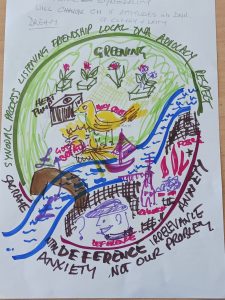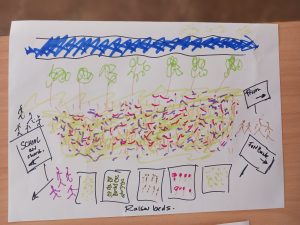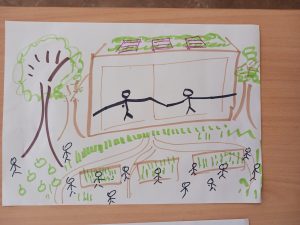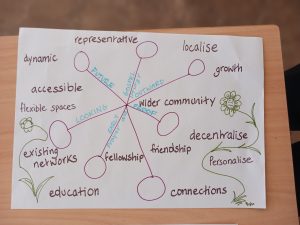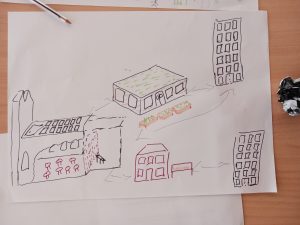 As indicated last month, the Commission hosted a meeting of the Northern Dioceses’ Environment Group on 08 June, at Wheeler Hall in Leeds. This is an open group of interested people from each of the Northern Dioceses, and they meet about 4 times a year
As indicated last month, the Commission hosted a meeting of the Northern Dioceses’ Environment Group on 08 June, at Wheeler Hall in Leeds. This is an open group of interested people from each of the Northern Dioceses, and they meet about 4 times a year
Five out of the seven dioceses in the North were represented, along with several people from our own diocese.
The meeting opened with a reflection led by Paul Kelly, from St Mary & St Michael parish in Settle. He included a great short video. It’s well worth taking a look.
Is this it?
‘Let us Dream’
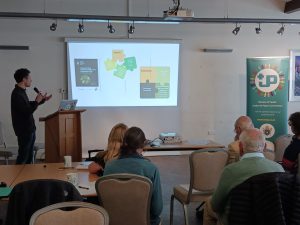
The major portion of the morning session was taken up with a workshop given by John Paul de Quay. John Paul works as a project manager for the Ecological Conversion Group. This charity was started after the pope published Laudato Si and is dedicated to inspiring action on care of creation (See their website for more details ( https://theecg.org/ ).
2030 is the year by which we should be reaching net zero emissions. John Paul explained that the work of the Ecological Conversion Group is about working alongside people to answer two basic questions:
- What will our communities look like once we have achieved net zero emissions?
- How do we get to that position – what are the things that we need to do
With limited time he asked everyone to focus on the first question – in the style of Pope Francis’s exhortation to ‘Let us dream’. So, in groups of 4 or 5, we were asked to come up with a drawing that would communicate the key aspects of our local community once net zero emissions were achieved. Some participants were a bit shy about drawing, but everyone had a go and became more enthusiastic as the workshop progressed.
At the end of the workshop, each group explained the different elements of their drawing, just in case it wasn’t totally obvious (the tables I drew ended up looking more like jellyfish to me!).
What is happening in the Leeds area?
We started the afternoon with an input from Helen Hayden, Leeds J&P Commission member and Executive member of Leeds City Council with responsibility for the council’s response to the Climate Emergency. Helen spoke with passion about the interconnectedness of Climate Change with other issues that people living in poverty experience. For example, how retrofitting some properties has enabled tenants to have their heating on more regularly. In one case the ambient temperature in a property prior to retrofitting was measured at 12C whereas after the work had been completed it was 18C. As one mother put it, this allowed her children to have a quiet space in their bedroom where they could comfortably sit and do their homework. So, not only did this work reduce carbon emissions, it also directly reduced energy bills for the people involved. Longer term, being able to do homework in a suitable space means that educational outcomes will be improved for the children living in those properties.
The challenge with this is that the council had funds from central government to retrofit relatively few properties – and even then, the funds were provided in competition with other local authorities. To retrofit all the properties in Leeds that need it will require £6billion of funding. In terms of both action on Climate Change and the Government’s ‘levelling up’ agenda this should be given much more priority.
Helen’s input really brought to life the interconnectedness of action for Climate Change and action on poverty.
Where do we go from here?
During the final part of the afternoon session everyone reflected on the rest of the day to see if any ideas for action were emerging.
There were several suggestions – some of them quite surprising.
One was to take benches out of churches! Not quite such a bonkers idea as it might sound. Pews create a very inflexible space – as anyone who has twisted round during Stations of the Cross or the Easter Vigil can testify. With chairs (and possibly some tables) liturgy can be more creatively imagined. More than that, with suitable screening for the sanctuary, the space can be used for non-liturgical purposes. We have some marvellous physical spaces but most of them are really constrained in what we can do with them because of the way that they are ordered. As a consequence they are used for only a few hours each week. We need to work with some imaginative architects so that most churches can be made into fully flexible spaces for both liturgical and community use.
It was noted that the last Bishop’s Conference meeting at Hinsley Hall (November 2022) had discussed Climate Action and everyone was looking forward to the publication of their deliberations about this. Looking ahead, 2025 will be the tenth anniversary of the publication of Laudato Si. The idea of holding a joint event with the Bishops from the Northern Dioceses was mooted. This could both celebrate the work done to date and review what the next steps were for all the northern dioceses to achieve net zero by 2030. Many suggested that this would be a great way to demonstrate synodality in action within the northern dioceses.

